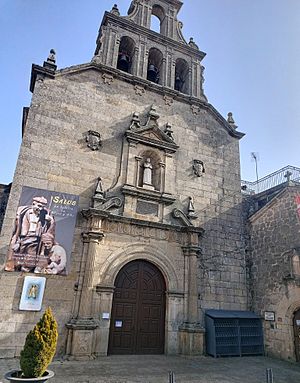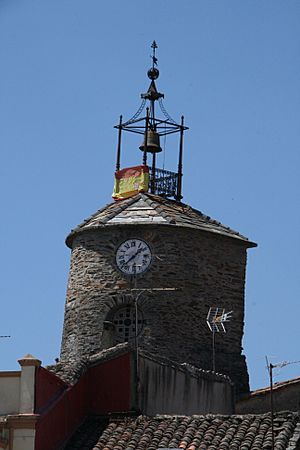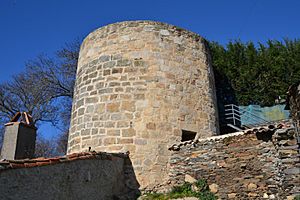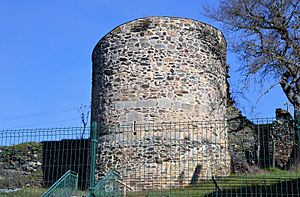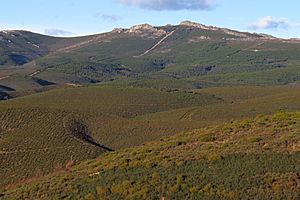Alcañices facts for kids
Quick facts for kids
Alcañices
Village of Alcañices
|
|||
|---|---|---|---|
|
County Capital and municipality
|
|||
| Alcañices | |||

Catholic Parish of Our Lady of the Assumption of Alcañices (13th century)
|
|||
|
|||
| Motto(s):
"Noble, Ilustre e Histórica Villa"
("Noble, Illustrious and Historical Village") |
|||
| Country | |||
| Autonomous community | |||
| Province | |||
| Comarca | Aliste | ||
| Mancomunidad | Tierras de Aliste | ||
| Area | |||
| • Total | 54.76 km2 (21.14 sq mi) | ||
| Elevation | 810 m (2,660 ft) | ||
| Population
(2018)
|
|||
| • Total | 1,074 | ||
| • Density | 19.613/km2 (50.797/sq mi) | ||
| Demonym(s) | Alcañizanos | ||
| Time zone | UTC+1 (CET) | ||
| • Summer (DST) | UTC+2 (CEST) | ||
| Postal code |
49500
|
||
| Climate | Csb | ||
Alcañices (Portuguese: Alcanizes) is a small town in the province of Zamora, Spain. It is very close to the border between Portugal and Spain. It is not far from the Portuguese town of Bragança. Alcañices is especially known for being the place where the Treaty of Alcañices was signed. This treaty, signed on September 12, 1297, set the border between Portugal and the Crown of Castile. It is the oldest border in Europe.
Its name comes from Arabic and means "the churches." The town might have started as an ancient hillfort built by the Zoelae people.
Contents
A Look at History
Early Times and Knights Templar
In ancient times, Alcañices was a free area. Later, in 586, King Liuvigild gave it to the Archbishop of Braga. But in 675, the Archbishop of Santiago de Compostela said it should be his.
During the time of the Reconquest, Alfonso IX of León gave Alcañices to the Order of the Temple in 1175. This was to help new people settle there. The Templars built a castle in 1210 and a Commandery (a Templar center) in 1255. People say that Saint Francis of Assisi visited Alcañices in 1214 while on a trip to Santiago de Compostela.
Manor Town and Modern Age
From 1371 to 1820, Alcañices was a manor town. It was ruled by the Marquises of Alcañices. In 1741, it became part of the Ducal House of Alburquerque. During this time, the Marquises built many useful things. They built a hospital for travelers, a grain storage building, a bridge, and several fountains and mills. They also helped create a Franciscan convent. This convent later became the Catholic Sanctuary of Our Lady of Health. The Marquises also built a palace inside the old fortress. Today, this palace is a home for the elderly.
In 1643, Alcañices was burned by John IV of Portugal. The town also saw battles during the Spanish War of Independence. In 1813, General La Croix surprised Mayor Echevarría here. Also, Marshal Massená sent soldiers to take Alcañices.
Jewish Quarter and Royal Visitors
Until 1492, Alcañices had a Jewish quarter. This area was outside the town walls. People in this area were known for tanning leather. They also had their own cemetery.
Many important people have visited Alcañices. Five kings have been here: Alfonso IX of León (in 1204), Ferdinand IV of Castile and Denis of Portugal (in 1297), and Juan Carlos I of Spain (in 1997). Fernando III of Castile also visited as a young prince in 1204. The President of Portugal, Jorge Sampaio, visited in 1997. He was later named an "Adoptive Son" of the town in 2006.
Alcañices has been given special titles over time. It is known as a "Noble, Illustrious, and Historic Village."
Culture and Nature
Local Heritage
Alcañices has interesting routes to explore. There is the Route of the Mills and the Route of the Fountains. You can also see two modern buildings, one designed by Francesc Ferriol. The town also has many examples of traditional local architecture.
From its Templar past, the Quinta de los Templarios still remains. This was an old Templar recreation estate. Pablo Muñoz de la Morena, a hero from the Spanish War of Independence, is buried in the old parish cemetery.
Traditions and Environment
Alcañices has a religious play called "Auto de los Reyes Magos" (Play of the Magi Kings). This play has been sung for a very long time and dates back to the Middle Ages. Since 1515, the village has had a Vera Cruz brotherhood. There are also three other brotherhoods and twelve local groups, including the Manteos y Monteras de Alcañices Folklore School.
Alcañices is located on a central plateau. Its land has gentle hills and valleys. It mixes dry landscapes with small mounds. The soil is mostly clay. The area is part of the Meseta Ibérica transboundary biosphere reserve. This is a natural area between Spain and Portugal. Unesco protected it in 2015 because its natural habitats and the animals living there are very well preserved. Alcañices is also next to the Sierra de la Culebra. This area is the largest wolf reserve in Europe.
Town Hall
Alcañices is the main town for four nearby villages:
- Alcañices (893 inhabitants, INE 2020).
- Alcorcillo (98 inhabitants, INE 2020).
- Vivinera (53 inhabitants, INE 2020).
- Santa Ana (21 inhabitants, INE 2020).
See also
 In Spanish: Alcañices para niños
In Spanish: Alcañices para niños





